display Citroen C4 CACTUS 2015 1.G Owner's Guide
[x] Cancel search | Manufacturer: CITROEN, Model Year: 2015, Model line: C4 CACTUS, Model: Citroen C4 CACTUS 2015 1.GPages: 326, PDF Size: 8.56 MB
Page 87 of 326
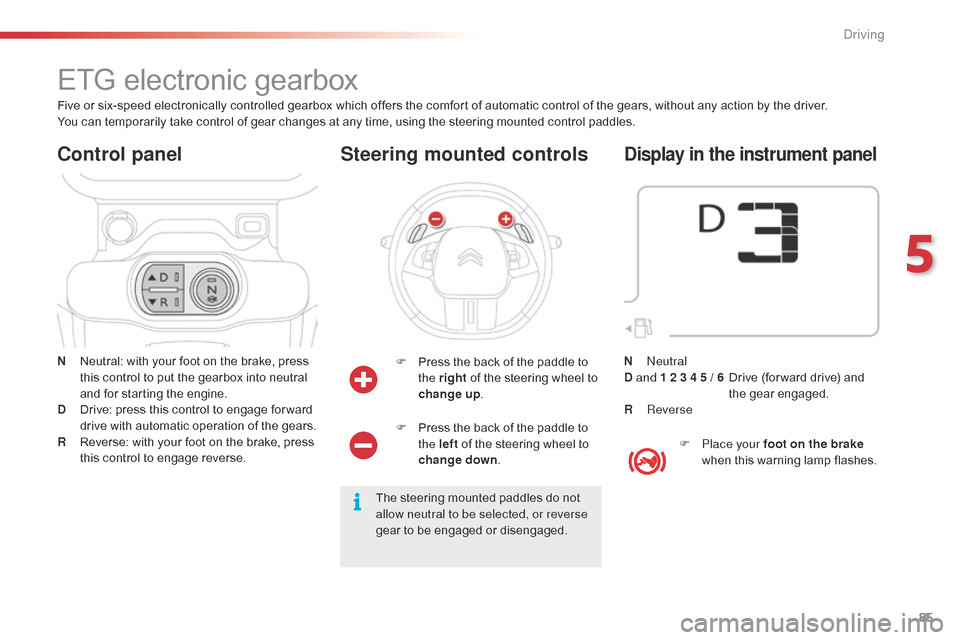
85
C4-cactus_en_Chap05_conduite_ed02-2014
ETGô electronicô gearbox
Nô Neutral:ô with ô your ô foot ô on ô the ô brake, ô press ô t
his ô control ô to ô put ô the ô gearbox ô into ô neutral ô
a
nd ô for ô starting ô the ô engine.
D
ô
D
rive: ô press ô this ô control ô to ô engage ô for ward ô
d
rive ô with ô automatic ô operation ô of ô the ô gears.
R
ô
R
everse: ô with ô your ô foot ô on ô the ô brake, ô press ô
t
his ô control ô to ô engage ô reverse.
Control panel
Fô Pressô the ô back ô of ô the ô paddle ô to ô t
he rightô of ô the ô steering ô wheel ô to ô
ch
ange up .
Steering mounted controls
Theô steeringô mountedô paddlesô doô notô a
llow neutral to be selected, or reverse
gear
ô to ô be ô engaged ô or ô disengaged.
Five
ô
or
ô
six-speed
ô
electronically
ô
controlled
ô
gearbox
ô
which
ô
offers ô the ô comfort ô of ô automatic ô control ô of ô the ô gears, ô without ô any ô action ô by ô the ô driver.
You
ô
can
ô
temporarily
ô
take
ô
control
ô
of
ô
gear
ô
changes
ô
at
ô
any
ô
time, ô using ô the ô steering ô mounted ô control ô paddles.
F ô
P
ress ô the ô back ô of ô the ô paddle ô to ô
t
he left
ô
of ô the ô steering ô wheel ô to ô
ch
ange down
.
Display in the instrument panel
F Place your foot on the brake
when ô this ô warning ô lamp ô flashes.
N
n
e
utral
D and 1 2 3 4 5 / 6 ô ô
D
rive ô (for ward ô drive) ô and ô
t
he
ô g
ear
ô enga
ged.
R
Reverse
5
Driving
Page 92 of 326
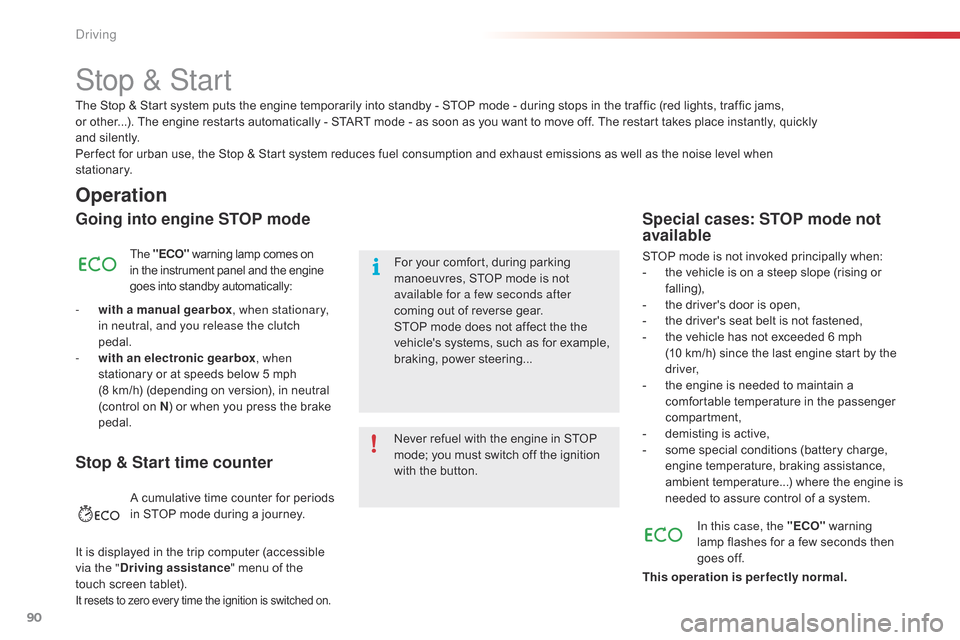
90
C4-cactus_en_Chap05_conduite_ed02-2014
Stop & Start
Operation
Going into engine STOP mode
The "ECO"ô warning ô lamp ô comes ô onô i
n ô the ô instrument ô panel ô and ô the ô engineô g
oes ô into ô standby ô automatically:
-
w
ith a manual gearbox , when stationary,
in neutral, and you release the clutch
pedal.
-
w
ith an electronic gearbox , when
stationary
ô or ô at ô speeds ô below ô 5 ô mph ô
(
8ô km/h) ô (depending ô on ô version), ô in ô neutral ô
(
control ô on ô N)
ô or ô when ô you ô press ô the ô brake ô
ped
al. Never
ô refuel ô with ô the ô engine ô in ô STOP ô
m
ode; ô you ô must ô switch ô off ô the ô ignition ô
w
ith ô the ô button.
For
ô your ô comfort, ô during ô parking ô
m
anoeuvres, ô STOP ô mode ô is ô not ô
a
vailable for a few seconds after
coming
ô out ô of ô reverse ô gear.
STOP
ô mode ô does ô not ô affect ô the ô the ô
v
ehicle's ô systems, ô such ô as ô for ô example, ô
b
raking, ô power ô steering...
Special cases: STOP mode not
available
STOPô modeô isô notô invokedô principallyô when:
- ô t he ô vehicle ô is ô on ô a ô steep ô slope ô (rising ô or ô
f
alling),
-
ô
t
he ô driver's ô door ô is ô open,
-
ô
t
he ô driver's ô seat ô belt ô is ô not ô fastened,
-
ô
t
he ô vehicle ô has ô not ô exceeded ô 6 ô mph ô
(
10ô km/h) ô since ô the ô last ô engine ô start ô by ô the ô
d
river,
-
ô
t
he ô engine ô is ô needed ô to ô maintain ô a ô
c
omfortable ô temperature ô in ô the ô passenger ô
c
ompartment,
-
ô
d
emisting ô is ô active,
-
ô
s
ome ô special ô conditions ô (battery ô charge, ô
e
ngine ô temperature, ô braking ô assistance, ô
a
mbient ô temperature...) ô where ô the ô engine ô is ô
n
eeded ô to ô assure ô control ô of ô a ô system.
In this case, the "ECO"
ô
warning ô
l
amp ô flashes ô for ô a ô few ô seconds ô then ô
g
oesô off.
This operation is perfectly normal.
The
ô
Stop
ô
&
ô
Startô system
ô
puts
ô
the
ô
engine
ô
temporarily
ô
into
ô
standby
ô
-
ô
STOP
ô
mode
ô
-
ô
during
ô
stops
ô
in
ô
the
ô
traffic ô (red ô lights, ô traffic ô jams, ô
or
ô
other...).
ô
Theô engine
ô
restarts
ô
automatically
ô
-
ô
START
ô
mode
ô
-
ô
as
ô
soon
ô
as
ô
you
ô
want
ô
to
ô
move
ô
off.
ô
The
ô
restart ô takes ô place ô instantly, ô quickly ô
and
ô
silently.
Per fect
ô
for
ô
urban
ô
use,
ô
the
ô
Stop
ô
&
ô
Start
ô
system
ô
reduces
ô
fuel
ô
consumption
ô
and
ô
exhaust
ô
emissions
ô
as
ô
well
ô as ô the ô noise ô level ô when ô
stationary.
Stop & Start time counter
Aô cumulativeô timeô counterô forô periodsô i n ô STOP ô mode ô during ô a ô journey.
It
ô
is
ô
displayed ô in ô the ô trip ô computer ô (accessible ô
v
ia the " Driving assistance "
ô menu ô of ô the ô
t
ouch
ô
screen ô tablet).
Itô resetsô toô zeroô everyô timeô theô ignitionô isô switchedô on.
driving
Page 94 of 326
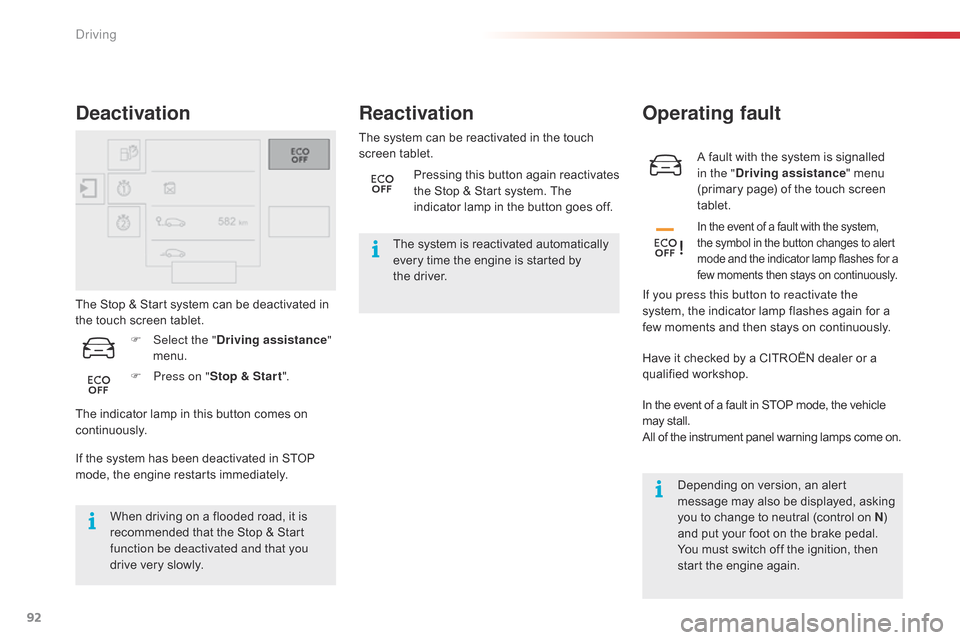
92
C4-cactus_en_Chap05_conduite_ed02-2014
Aô faultô withô theô systemô isô signalledô in the " Driving assistance "
ô menu ô
(
primary ô page) ô of ô the ô touch ô screen ô
t
ablet.
Operating fault
Inô theô eventô ofô aô faultô withô theô system,ô the ô symbol ô in ô theô button ô changes ô to ô alertô m
ode ô and ô the ô indicator ô lamp ô flashes ô for ô a
ô f
ew ô moments ô then ô stays ô on ô continuously.
If you press this button to reactivate the
system,ô the ô indicator ô lamp ô flashes ô again ô for ô a ô
f
ew ô moments ô and ô then ô stays ô on ô continuously.
The
ô
Stop
ô
&
ô
Start
ô
system
ô
can
ô
be
ô
deactivated
ô
in
ô
t
he
ô
touch
ô
screen
ô
tablet.
Deactivation
Ifô theô systemô hasô beenô deactivatedô inô STOPô m ode, ô the ô engine ô restarts ô immediately.
When
ô driving ô on ô a ô flooded ô road, ô it ô is ô
r
ecommended ô that ô the ô Stop ô & ô Start ô
f
unction be deactivated and that you
drive
ô very ô slowly. The
ô system ô can ô be ô reactivated ô in ô the ô touch ô
s
creen
ô t
ablet.
Reactivation
Theô systemô isô reactivatedô automaticallyô e
very ô time ô the ô engine ô is ô started ô by ô
t
heô driver.
F
P
ress on " Stop & Star t ".
F
Sel
ect the " Driving assistance "
menu.
The
ô
indicator
ô
lamp
ô
in
ô
this
ô
button
ô
comes
ô
on
ô
c
ontinuously. Pressing
ô this ô
b
utton ô again ô reactivates ô
t
he ô Stop ô & ô Start ô system. ô The ô
i
ndicator ô lamp ô in ô the ô button ô goes ô off.
Have ô it ô checked ô by ô a ô CITROûN ô dealer ô or ô a ô
q
ualified
ô w
orkshop.
In
ô the ô event ô of ô a ô fault ô in ô STOP ô mode, ô the ô vehicle
ô m
ay ô stall.
All
ô of ô the ô instrument ô panel ô warning ô lamps ô come ô on.
Depending
ô on ô version, ô an ô alert ô
m
essage ô may ô also ô be ô displayed, ô asking ô
y
ou ô to ô change ô to ô neutral ô (control ô on ô N)
ô
a
nd ô put ô your ô foot ô on ô the ô brake ô pedal.
You
ô must ô switch ô off ô the ô ignition, ô then ô
s
tart ô the ô engine ô again.
driving
Page 95 of 326
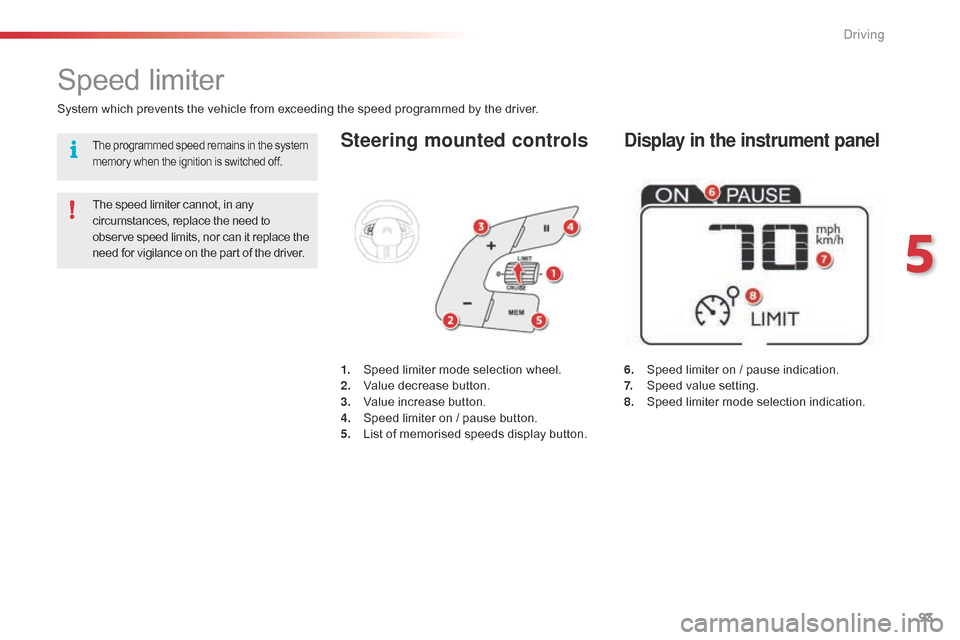
93
C4-cactus_en_Chap05_conduite_ed02-2014
Steering mounted controls
6.ô Speedô limiter ô on ô / ô pause ô indication.
7.ô S peed ô value ô setting.
8.
ô S
peed ô limiter ô mode ô selection ô indication.
Speedô limiter
Systemô whichô preventsô theô vehicleô fromô exceedingô theô speedô programmedô byô theô driver.
T he ô speed ô limiter ô cannot, ô in ô any
ô c
ircumstances, ô replace ô the ô need ô to
ô o
bserve ô speed ô limits, ô nor ô can ô it ô replace ô the
ô n
eed ô for ô vigilance ô on ô the ô part ô of ô the ô driver.1.
ô S
peed ô limiter ô mode ô selection ô wheel.
2.
ô V
alue ô decrease ô button.
3.
ô V
alue ô increase ô button.
4.
ô S
peed ô limiter ô on ô / ô pause ô button.
5.
ô L
ist ô of ô memorised ô speeds ô display ô button.
Display in the instrument panelTheô programmedô speedô remainsô inô theô systemô memory ô when ô the ô ignition ô is ô switched ô off.
5
Driving
Page 96 of 326
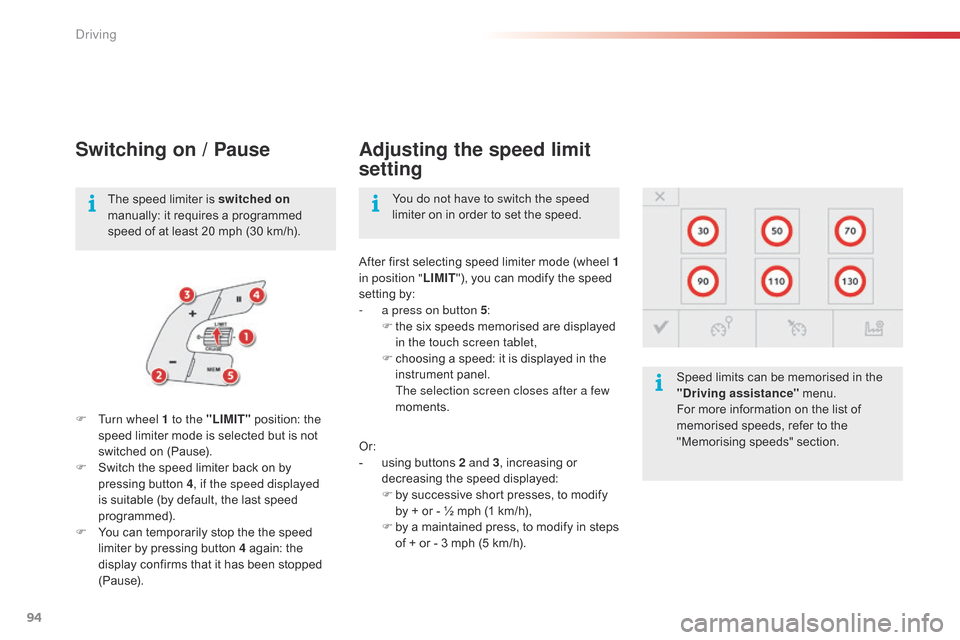
94
C4-cactus_en_Chap05_conduite_ed02-2014
Switching on / Pause
F Turn wheel 1 to the "LIMIT"ô position: ô the ô s
peed ô limiter ô mode ô is ô selected ô but ô is ô not ô
s
witched ô on ô (Pause).
F
ô
S
witch ô the ô speed ô limiter ô back ô on ô by ô
p
ressing ô button ô 4, if the speed displayed
is
ô suitable ô (by ô default, ô the ô last ô speed ô
pro
grammed).
F
ô
Y
ou ô can ô temporarily ô stop ô the ô the ô speed ô
l
imiter ô by ô pressing ô button ô 4 ô again: ô the ô
d
isplay ô confirms ô that ô it ô has ô been ô stopped ô
(
Pause). After
ô first ô selecting ô speed ô limiter ô mode ô (wheel ô 1
in position " LIMIT"), ô you ô can ô modify ô the ô speed ô
s
etting ô by:
-
a p
ress on button 5
:
F ô
t
he ô six ô speeds ô memorised ô are ô displayed ô
i
n the touch screen tablet,
F ô
c
hoosing ô a ô speed: ô it ô is ô displayed ô in ô the ô
in
strument
ô pan
el.
T
he selection screen closes after a few
moments. Speed ô limits ô can ô be ô memorised ô in ô the ô
"
Driving assistance"
ô
menu.
For ô more ô information ô on ô the ô list ô of ô m
emorised ô speeds, ô refer ô to ô the ô
"
Memorising ô speeds" ô section.
You do not have to switch the speed
limiter
ô on ô in ô order ô to ô set ô the ô speed.
The ô speed ô limiter ô is ô switched on
manually: ô it ô requires ô a ô programmed ô
s
peed ô of ô at ô least ô 20 ô mph ô (30 ô km/h).
Adjusting the speed limit
setting
Or:
-
ô u sing ô buttons ô 2 and 3,
ô increasing ô or ô
d
ecreasing ô the ô speed ô displayed:
F
ô
b
y ô successive ô short ô presses, ô to ô modify ô
b
y ô + ô or ô - ô ô§ ô mph ô (1 ô km/h),
F
ô
b
y ô a ô maintained ô press, ô to ô modify ô in ô steps ô
o
f ô + ô or ô - ô 3 ô mph ô (5 ô km/h).
Driving
Page 97 of 326

95
C4-cactus_en_Chap05_conduite_ed02-2014
on sharp acceleration, as when
descendingô a ô steep ô hill, ô the ô speed ô
l
imiter ô will ô not ô be ô able ô to ô prevent ô
t
he ô vehicle ô from ô exceeding ô the ô
pro
grammed
ô s
peed.
The
ô limiter ô is ô temporarily ô deactivated ô
a
nd ô the ô displayed ô programmed ô speed ô
f
lashes.
An
ô audible ô signal ô accompanies ô the ô
f
lashing ô of ô the ô programmed ô speed ô
w
hen ô exceeding ô the ô speed ô is ô not ô due ô to ô
a
n ô action ô by ô the ô driver.
The
ô use ô of ô mats ô not ô approved ô by ô
C
ITROûN ô may ô inter fere ô with ô the ô
o
peration ô of ô the ô speed ô limiter.
To
ô avoid ô any ô risk ô of ô jamming ô of ô the ô
ped
als:
-
ô
e
nsure ô that ô the ô mat ô is ô secured ô
c
o r r e c t l y,
-
ô
d
o ô not ô fit ô one ô mat ô on ô top ô of ô another.
Flashing
ô
of
ô
the
ô
dashes
ô
indicates
ô
a
ô
fault
ô
with
ô
the
ô sp
eedô l
imiter.
Have
ô
it
ô
checked
ô
by
ô
a
ô
CITROûN
ô
dealer
ô
or
ô
a
ô
q
ualified
ô w
orkshop.
Operating fault
Switching off
F Turn wheel 1 to the "0"ô p osition.ô T
he ô display ô of ô information ô related ô to ô the ô
sp
eed
ô l
imiter
ô d
isappears.
F
Press
firmly on the accelerator pedal,
going ô beyond ô the ô point of resistance,
to
exceed ô the ô programmed ô speed ô limit.
The ô speed ô limiter ô is ô deactivated ô temporarily ô
a
nd ô the ô displayed ô programmed ô speed ô flashes.
Temporarily exceeding the
programmed speed
Asô soonô asô theô vehicle'sô speedô returnsô toô theô p
rogrammed ô value, ô the ô limiter ô operates ô again: ô
t
he ô display ô of ô the ô programmed ô speed ô setting ô
b
ecomes ô steady ô again.
An
ô audible ô signal ô accompanies ô the ô
f
lashing ô of ô the ô programmed ô speed ô
w
hen ô exceeding ô the ô speed ô is ô not ô due ô to ô
a
n ô action ô by ô the ô driver ô (steep ô hill...).
5
driving
Page 98 of 326
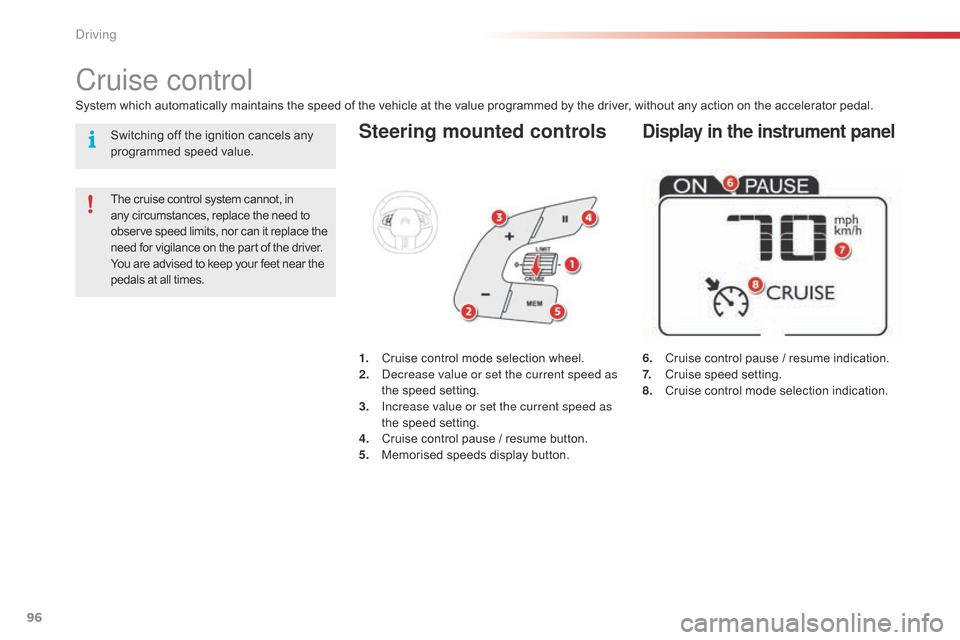
96
C4-cactus_en_Chap05_conduite_ed02-2014
Steering mounted controls
6.ô Cruiseô control ô pause ô / ô resume ô indication.
7.ô C ruise ô speed ô setting.
8.
ô C
ruise ô control ô mode ô selection ô indication.
Cruise control
Systemô whichô automaticallyô maintainsô theô speedô ofô theô vehicleô atô theô valueô programmedô byô theô driver,ô withoutô anyô actionô onô theô acceleratorô pedal.
T he ô cruise ô control ô system ô cannot, ô in
ô a
ny ô circumstances, ô replace ô the ô need ô to
ô o
bserve ô speed ô limits, ô nor ô can ô it ô replace ô the
ô n
eed ô for ô vigilance ô on ô the ô part ô of ô the ô driver.
You
ô are ô advised ô to ô keep ô your ô feet ô near ô the
ô p
edals ô at ô all ô times. 1.
ô C
ruise ô control ô mode ô selection ô wheel.
2.
d
e
crease value or set the current speed as
the
ô speed ô setting.
3.
I
ncrease value or set the current speed as
the
ô speed ô setting.
4.
ô C
ruise ô control ô pause ô / ô resume ô button.
5.
ô M
emorised ô speeds ô display ô button.
Display in the instrument panelSwitchingô offô theô ignitionô cancelsô anyô programmed ô speed ô value.
Driving
Page 99 of 326
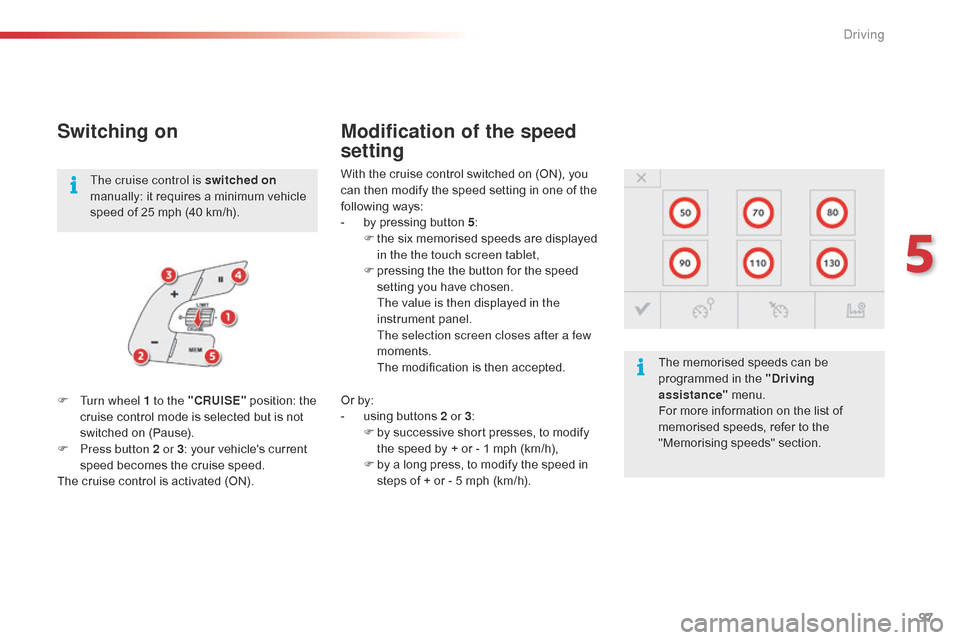
97
C4-cactus_en_Chap05_conduite_ed02-2014
Switching on
Withô theô cruiseô controlô switchedô onô (ON),ô youô can ô then ô modify ô the ô speed ô setting ô in ô one ô of ô the ô
f
ollowing
ô w
ays:
-
ô
b
y ô pressing ô button ô 5:
F
ô
t
he ô six ô memorised ô speeds ô are ô displayed ô
i
n the the touch screen tablet,
F
ô
p
ressing ô the ô the ô button ô for ô the ô speed ô
s
etting ô you ô have ô chosen.
T
he value is then displayed in the
instrument
ô pan
el.
T
he selection screen closes after a few
moments.
ô T
he ô modification ô is ô then ô accepted.
F
T
urn wheel 1 to the "CRUISE"
ô
position:
ô
the
ô
c
ruise
ô
control
ô
mode
ô
is
ô
selected
ô
but
ô
is
ô
not
ô
s
witched
ô
on
ô
(Pause).
F
P
ress button 2 or 3 :
ô
your
ô
vehicle's
ô
current
ô
s
peed
ô
becomes
ô
the
ô
cruise
ô
speed.
The
ô
cruise
ô
control
ô
is
ô
activated
ô
(ON).
Modification of the speed
setting
The cruise control is switched on
manually: ô it ô requires ô a ô minimum ô vehicle ô
s
peed ô of ô 25 ô mph ô (40 ô km/h).
The
ô memorised ô speeds ô can ô be ô
p
rogrammed ô in ô the ô "Driving
assistance"
ô
menu.
For
ô more ô information ô on ô the ô list ô of ô
m
emorised ô speeds, ô refer ô to ô the ô
"
Memorising ô speeds" ô section.
Or
ô by:
-
ô
u
sing ô buttons ô 2 or 3:
F
ô
b
y ô successive ô short ô presses, ô to ô modify ô
t
he ô speed ô by ô + ô or ô - ô 1 ô mph ô (km/h),
F
ô
b
y ô a ô long ô press, ô to ô modify ô the ô speed ô in ô
s
teps ô of ô + ô or ô - ô 5 ô mph ô (km/h).
5
Driving
Page 100 of 326
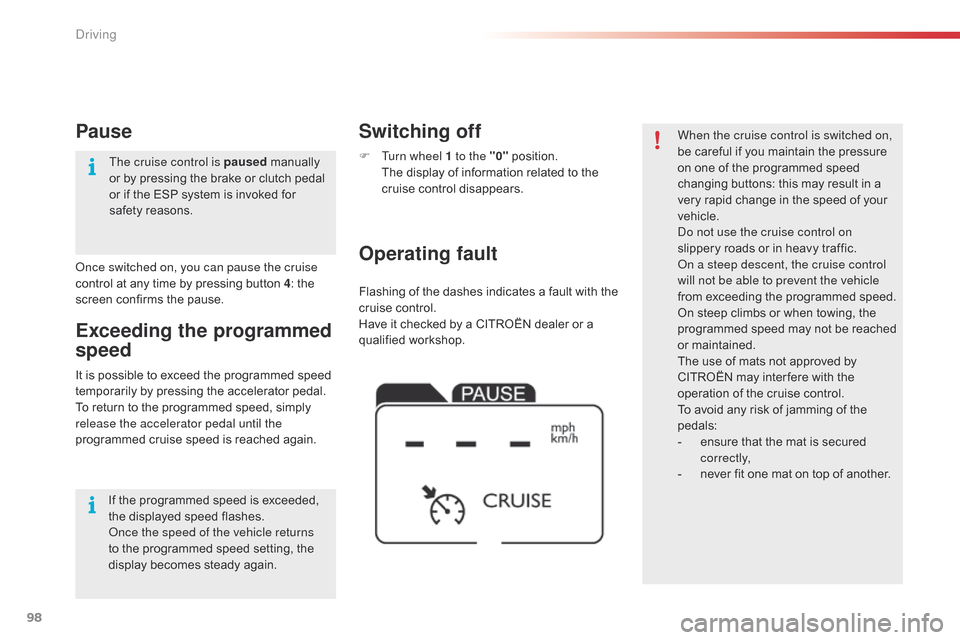
98
C4-cactus_en_Chap05_conduite_ed02-2014
Flashingô ofô theô dashesô indicatesô aô faultô withô theô cruise ô control.
Have
ô it ô checked ô by ô a ô CITROûN ô dealer ô or ô a ô
q
ualified
ô w
orkshop.
Operating fault Switching off
F Turn wheel 1 to the "0"ô p osition.ô T
he ô display ô of ô information ô related ô to ô the ô
c
ruise ô control ô disappears. When the cruise control is switched on,
be
ô careful ô if ô you ô maintain ô the ô pressure ô o
n ô one ô of ô the ô programmed ô speed ô
c
hanging ô buttons: ô this ô may ô result ô in ô a ô
v
ery ô rapid ô change ô in ô the ô speed ô of ô your ô
v
ehicle.
do n
ot use the cruise control on
slippery
ô roads ô or ô in ô heavy ô traffic.
on a s
teep descent, the cruise control
will not be able to prevent the vehicle
from
ô exceeding ô the ô programmed ô speed.
On
ô steep ô climbs ô or ô when ô towing, ô the ô
p
rogrammed ô speed ô may ô not ô be ô reached ô
o
r ô maintained.
The
ô use ô of ô mats ô not ô approved ô by ô
C
ITROûN ô may ô inter fere ô with ô the ô
o
peration ô of ô the ô cruise ô control.
To
ô avoid ô any ô risk ô of ô jamming ô of ô the ô
ped
als:
-
ô
e
nsure ô that ô the ô mat ô is ô secured ô
c
o r r e c t l y,
-
ô
n
ever ô fit ô one ô mat ô on ô top ô of ô another.
It
ô
is
ô
possible
ô
to
ô
exceed
ô
the
ô
programmed
ô
speed
ô
t
emporarily
ô
by
ô
pressing
ô
the
ô
accelerator
ô
pedal.
To
ô
return
ô
to
ô
the
ô
programmed
ô
speed,
ô
simply
ô
r
elease the accelerator pedal until the
programmed
ô
cruise
ô
speed
ô
is
ô
reached
ô
again.
Exceeding the programmed
speed
once switched on, you can pause the cruise
control ô at ô any ô time ô by ô pressing ô button ô 4: ô the ô
s
creen ô confirms ô the ô pause.
Pause
Ifô theô programmedô speedô isô exceeded,ô the ô displayed ô speed ô flashes.
on
ce the speed of the vehicle returns
to
ô the ô programmed ô speed ô setting, ô the ô
d
isplay ô becomes ô steady ô again.
The cruise control is paused
ô m
anually
ô o
r ô by ô pressing ô the ô brake ô or ô clutch ô pedal ô
o
r ô if ô the ô ESP ô system ô is ô invoked ô for ô
s
afety ô reasons.
Driving
Page 102 of 326
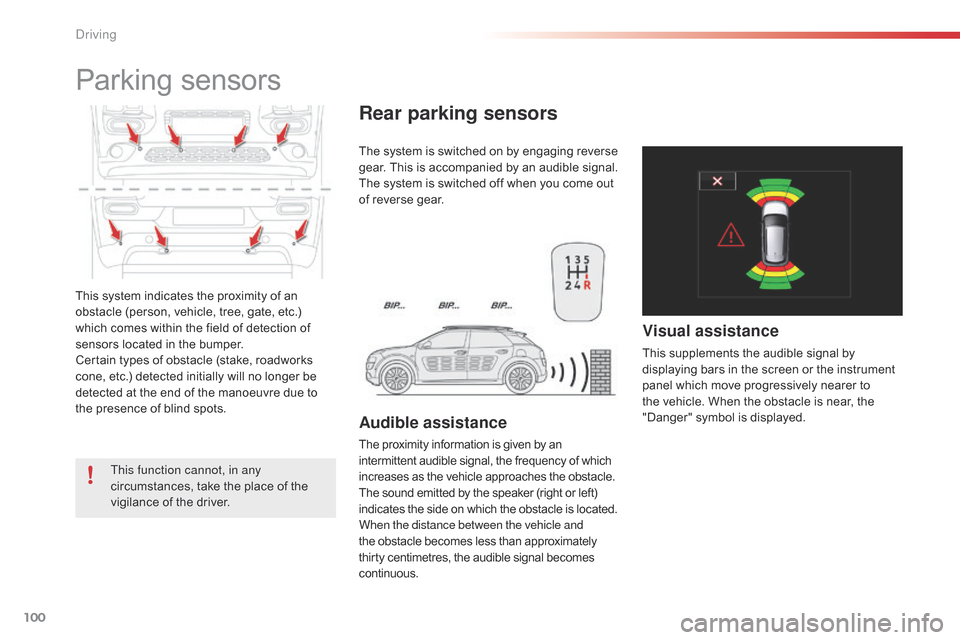
100
C4-cactus_en_Chap05_conduite_ed02-2014
Thisô systemô indicatesô theô proximityô ofô anô obstacle ô (person, ô vehicle, ô tree, ô gate, ô etc.) ô
w
hich ô comes ô within ô the ô field ô of ô detection ô of ô
s
ensors ô located ô in ô the ô bumper.
Certain
ô types ô of ô obstacle ô (stake, ô roadworks ô
c
one, ô etc.) ô detected ô initially ô will ô no ô longer ô be ô
d
etected ô at ô the ô end ô of ô the ô manoeuvre ô due ô to ô
t
he ô presence ô of ô blind ô spots.
Parkingô sensors
This function cannot, in any
circumstances,ô take ô the ô place ô of ô the ô
v
igilance ô of ô the ô driver. The
ô system ô is ô switched ô on ô by ô engaging ô reverse ô
g
ear. ô This ô is ô accompanied ô by ô an ô audible ô signal.
The ô system ô is ô switched ô off ô when ô you ô come ô out ô
o
f ô reverse ô gear.
Audible assistance
Theô proximityô informationô isô givenô byô anô i
ntermittent ô audible ô signal, ô the ô frequency ô of ô whichô i
ncreases ô as ô the ô vehicle ô approaches ô the ô obstacle.
The
ô sound ô emitted ô by ô the ô speaker ô (right ô or ô left)
ô i
ndicates ô the ô side ô on ô which ô the ô obstacle ô is ô located.
When the distance between the vehicle and
the
ô obstacle ô becomes ô less ô than ô approximately
ô t
hirty ô centimetres, ô the ô audible ô signal ô becomes
ô c
ontinuous.
Rear parking sensors
Visual assistance
Thisô supplementsô theô audibleô signalô byô d isplaying ô bars ô in ô the ô screen ô or ô the ô instrument ô
p
anel ô which ô move ô progressively ô nearer ô to ô
t
he ô vehicle. ô When ô the ô obstacle ô is ô near, ô the ô
"
Danger" ô symbol ô is ô displayed.
driving